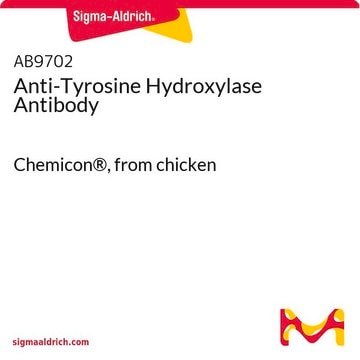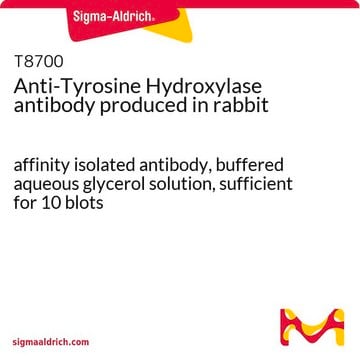AB5986
Anti-Tyrosine Hydroxylase Antibody
serum, Chemicon®
Synonym(s):
TH, Tyrosine Monooxygenase
Sign Into View Organizational & Contract Pricing
All Photos(1)
About This Item
UNSPSC Code:
12352203
eCl@ss:
32160702
NACRES:
NA.41
Recommended Products
biological source
rabbit
Quality Level
antibody form
serum
antibody product type
primary antibodies
clone
polyclonal
species reactivity
rat
manufacturer/tradename
Chemicon®
technique(s)
immunohistochemistry: suitable
NCBI accession no.
UniProt accession no.
shipped in
dry ice
target post-translational modification
unmodified
Gene Information
rat ... Th(25085)
Specificity
Tyrosine Hydroxylase. Immunohistochemical distribution throughout the brain shows that staining is restricted to those neurons known to contain the enzyme. The antibody has proven useful in staining catecholaminergic neurons. AB5986 stains these neurons intensely, including dendritic processes and fine nerve terminals.
Immunogen
Synthetic peptide corresponding to amino acids 32-47 of rat Tyrosine Hydroxylase.
Application
Immunohistochemistry: 1:2,000-1:4,000.
Optimal working dilutions must be determined by end user.
Optimal working dilutions must be determined by end user.
Research Category
Neuroscience
Neuroscience
Research Sub Category
Neurotransmitters & Receptors
Neuronal & Glial Markers
Neurotransmitters & Receptors
Neuronal & Glial Markers
This Anti-Tyrosine Hydroxylase Antibody is validated for use in IH for the detection of Tyrosine Hydroxylase.
Physical form
Rabbit serum. Lyophilized. Reconstitute with 50 μL of sterile distilled water. Centrifuge to remove any insoluble material. Contains no preservative.
Storage and Stability
Maintain lyophilized material frozen at -20°C to -70°C for up to 12 months. After reconstitution maintain at -20°C in undiluted aliquots for up to 6 months. Avoid repeated freeze/thaw cycles. Glycerol (1:1, ACS or better grade) can be added for additional stability.
Analysis Note
Control
POSITIVE CONTROL: brain (sympathetic nerve terminals) and adrenal glands.
POSITIVE CONTROL: brain (sympathetic nerve terminals) and adrenal glands.
Legal Information
CHEMICON is a registered trademark of Merck KGaA, Darmstadt, Germany
Disclaimer
Unless otherwise stated in our catalog or other company documentation accompanying the product(s), our products are intended for research use only and are not to be used for any other purpose, which includes but is not limited to, unauthorized commercial uses, in vitro diagnostic uses, ex vivo or in vivo therapeutic uses or any type of consumption or application to humans or animals.
Not finding the right product?
Try our Product Selector Tool.
recommended
Storage Class Code
11 - Combustible Solids
WGK
WGK 3
Flash Point(F)
Not applicable
Flash Point(C)
Not applicable
Certificates of Analysis (COA)
Search for Certificates of Analysis (COA) by entering the products Lot/Batch Number. Lot and Batch Numbers can be found on a product’s label following the words ‘Lot’ or ‘Batch’.
Already Own This Product?
Find documentation for the products that you have recently purchased in the Document Library.
S M Miller et al.
Neuroscience, 159(4), 1384-1396 (2009-05-05)
Dopamine receptor activity in the rodent medial preoptic area (mPOA) is crucial for the display of maternal behaviors, as well as numerous other physiological and behavioral functions. However, the origin of dopaminergic input to the mPOA has not been identified
Neurotransmitters in airway parasympathetic neurons altered by neurotrophin-3 and repeated allergen challenge.
Pan, J; Rhode, HK; Undem, BJ; Myers, AC
American Journal of Respiratory Cell and Molecular Biology null
Effect of anti-NGF on ovarian expression of alpha1- and beta2-adrenoceptors, TrkA, p75NTR, and tyrosine hydroxylase in rats with steroid-induced polycystic ovaries.
Manni, L; Holmang, A; Cajander, S; Lundeberg, T; Aloe, L; Stener-Victorin, E
American Journal of Physiology. Regulatory, Integrative and Comparative Physiology null
Alice Drobny et al.
Translational neurodegeneration, 12(1), 31-31 (2023-06-14)
Lysosomal dysfunction has been implicated in a number of neurodegenerative diseases such as Parkinson's disease (PD). Various molecular, clinical and genetic studies have highlighted a central role of lysosomal pathways and proteins in the pathogenesis of PD. Within PD pathology
Jennie L Close et al.
Neuron, 93(5), 1035-1048 (2017-03-11)
GABAergic interneurons are essential for neural circuit function, and their loss or dysfunction is implicated in human neuropsychiatric disease. In vitro methods for interneuron generation hold promise for studying human cellular and functional properties and, ultimately, for therapeutic cell replacement. Here
Our team of scientists has experience in all areas of research including Life Science, Material Science, Chemical Synthesis, Chromatography, Analytical and many others.
Contact Technical Service








